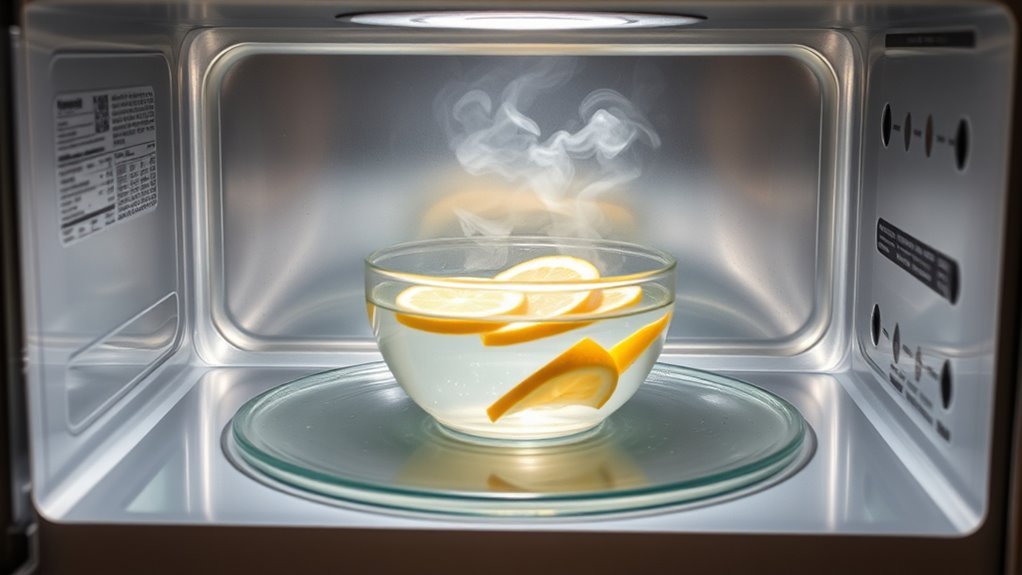Cleaning With Microwave: What Works and What Doesn’T
Cleaning your microwave is most effective with steam generated from water mixed with vinegar or lemon juice; this loosens grime and neutralizes odors without harsh chemicals that can damage components or leave residues. Avoid abrasive scrubbers that scratch surfaces and promote bacterial growth. For stubborn stains, a gentle baking soda paste works well. Using microwave-safe containers for steam cleaning prevents hazards. Maintaining tools like microfiber cloths and soft sponges improves results. To optimize cleanliness and appliance longevity, explore these smart techniques further.
How Steam Cleaning Revitalizes Your Microwave

How exactly does steam cleaning rejuvenate your microwave? Steam cleaning techniques utilize the power of heated water vapor to loosen and dissolve stubborn food residues. When you place a bowl of water inside your microwave and run it for several minutes, steam fills the interior, softening dried spills and grime. This method is effective without harsh chemicals, making it a safe choice. The steam cleaning advantages include minimal effort, reduced scrubbing, and prevention of scratches on delicate surfaces. Plus, it helps sanitize by killing some bacteria and neutralizing odors. By adopting this approach, you maintain your microwave’s efficiency and appearance effortlessly, giving you the freedom to enjoy a clean appliance without extensive labor or chemical exposure. It’s a smart, eco-friendly way to keep your microwave fresh and functional.
The Power of Vinegar and Lemon for Odor Removal
While steam effectively loosens grime and sanitizes your microwave, it may not completely eliminate lingering odors. To tackle persistent smells, you can harness the vinegar benefits and lemon properties, both scientifically proven to neutralize odors. Vinegar’s acetic acid breaks down odor-causing molecules, deodorizing the microwave interior without harsh residues. Meanwhile, lemon’s natural citric acid and antimicrobial qualities not only reduce smells but leave a fresh scent behind. To use, combine equal parts water and vinegar or fresh lemon juice in a microwave-safe bowl, then heat until the solution steams. This method loosens odor particles and sanitizes simultaneously. By choosing these natural agents, you maintain a chemical-free environment while enjoying effective odor removal, granting you freedom from unpleasant microwave smells with minimal effort.
Why Harsh Chemicals Should Be Avoided

Because harsh chemicals often contain volatile compounds and strong solvents, using them inside your microwave can pose health risks and damage the appliance. You should avoid these substances for several reasons:
- Chemical residues may linger on surfaces, contaminating your food and increasing health risks.
- Strong solvents can degrade microwave components, shortening its lifespan.
- Volatile compounds released during heating can emit harmful fumes, affecting indoor air quality.
- Harsh chemicals often react unpredictably with microwave radiation, potentially causing sparks or fires.
Choosing gentle, natural cleaning agents helps you maintain a safe environment while preserving your microwave’s integrity. This approach aligns with your desire for freedom from toxic exposure and costly repairs.
Using Baking Soda for Stubborn Stains
One of the most effective methods for tackling stubborn stains in your microwave involves using baking soda due to its mild abrasiveness and alkaline properties. To create a baking soda paste, mix baking soda with a small amount of water until it forms a spreadable consistency. Apply this paste directly onto the stubborn stain and let it sit for 10-15 minutes. The alkaline nature of baking soda helps break down acidic residues, while its gentle abrasiveness aids in loosening dried-on grime without damaging surfaces. Afterward, scrub the area lightly with a sponge or cloth and wipe clean with a damp rag. This method provides an eco-friendly, chemical-free approach to stubborn stain removal, allowing you to maintain your microwave’s cleanliness effectively without compromising your freedom from harsh cleaning agents.
The Role of Microwave-Safe Containers in Cleaning

When you use microwave-safe containers during cleaning, you guarantee both safety and effectiveness. Microwave safety depends largely on the container materials you choose. Here’s why selecting the right containers matters:
- Heat Resistance: Microwave-safe containers withstand high temperatures without melting or warping, ensuring consistent cleaning results.
- Non-Toxicity: Approved materials like glass or certain plastics prevent harmful chemicals from leaching into your cleaning solutions.
- Even Energy Distribution: Proper container materials allow microwaves to penetrate evenly, enhancing cleaning efficiency.
- Avoiding Sparks and Damage: Metal or non-certified plastics can cause sparks or damage your microwave, compromising safety.
Common Myths About Microwave Cleaning Debunked
Although microwave cleaning is a convenient method, you might encounter several misconceptions that could affect how you use it. Myth busting is essential to guarantee you apply microwave cleaning effectively and safely. One common cleaning misconception is that microwaving alone disinfects all bacteria; however, it primarily loosens grime and kills some germs but doesn’t ensure complete sterilization. Another myth suggests you can clean any material inside the microwave; in reality, only microwave-safe containers should be used to avoid damage. Additionally, some believe that microwaving vinegar or lemon juice will instantly eliminate odors, but it mainly softens residues, requiring manual wiping afterward. Understanding these precise facts helps you harness microwave cleaning wisely without risking appliance damage or ineffective results.
Effective Tools You Need for Microwave Cleaning
To clean your microwave effectively, you’ll need a set of essential supplies like microfiber cloths and sponges designed for delicate surfaces. Using natural cleaning agents such as vinegar or lemon juice can enhance sanitation without harsh chemicals. Additionally, specialty tools like microwave-safe steam cleaners can target stubborn residues efficiently.
Essential Cleaning Supplies
Before you begin cleaning your microwave, gathering the right supplies is vital for effective and efficient results. Having the essential supplies and cleaning tools on hand guarantees you tackle grime without unnecessary effort or damage. Here are four critical cleaning tools you need:
- Microfiber Cloths – These are gentle yet effective at removing residues without scratching surfaces.
- Soft Sponge – Ideal for scrubbing stubborn spots while protecting the microwave’s interior.
- Spray Bottle – Useful for applying water or cleaning solutions evenly.
- Rubber Gloves – Protect your hands from chemicals and hot surfaces during cleaning.
Natural Cleaning Agents
Three natural cleaning agents stand out for their effectiveness and safety when cleaning your microwave: vinegar, lemon, and baking soda. Vinegar acts as a powerful natural disinfectant, breaking down grease and neutralizing odors through its acetic acid content. Lemon provides a dual function—its citric acid dissolves residues while releasing a fresh scent, making it an excellent eco friendly alternative to chemical cleaners. Baking soda is mildly abrasive, ideal for scrubbing stubborn stains without scratching surfaces. Using these agents minimizes exposure to harsh chemicals, supporting healthier indoor air quality. To clean, you can heat a mixture of water and vinegar or lemon juice inside the microwave, allowing steam to loosen grime. Then, apply baking soda paste for tough spots. These natural disinfectants empower you to maintain a clean microwave efficiently and responsibly.
Specialty Microwave Tools
Several specialty tools can greatly enhance the efficiency and thoroughness of your microwave cleaning process. Using the right equipment guarantees you remove residue without damaging interior surfaces or components.
- Microwave brushes – Designed with soft bristles, these reach tight corners and vents, loosening stuck particles without scratching.
- Specialized wipes – Pre-moistened with safe cleaning agents, they sanitize and degrease quickly, reducing bacterial buildup.
- Steam cleaning accessories – Attachments that produce controlled steam help soften grime, making it easier to wipe away.
- Non-abrasive scrapers – Useful for lifting hardened food deposits gently without harming the microwave’s lining.
Employing these tools optimizes your cleaning routine, preserving your microwave’s performance and extending its lifespan while giving you freedom from stubborn stains.
How to Prevent Future Microwave Messes
To minimize microwave messes, you should always cover your food with a microwave-safe lid or wrap to prevent splatters. Establishing a consistent cleaning routine helps remove residues before they harden and become difficult to clean. These practices not only keep your microwave hygienic but also extend its functional lifespan.
Cover Food Properly
Although it might seem minor, properly covering your food in the microwave is essential for preventing splatters and reducing cleaning time. Effective food coverage directly enhances microwave safety by minimizing contamination and uneven heating. To optimize your microwave use, follow these guidelines:
- Use microwave-safe covers or lids designed to allow steam to escape, preventing pressure buildup.
- Avoid tightly sealed containers that can trap steam and cause spills or explosions.
- Utilize microwave-safe plastic wrap loosely, ensuring it doesn’t touch the food to prevent chemical leaching.
- Cover dishes with a damp paper towel for simple, disposable protection against splatter.
Regular Cleaning Routine
Properly covering your food reduces splatters, but maintaining a consistent cleaning routine is key to preventing buildup and odors in your microwave. Establishing daily habits, such as wiping down the interior after each use with a damp cloth or sponge, limits residue accumulation. Incorporate a weekly cleaning schedule involving a steam-clean method—heating a bowl of water with lemon or vinegar—to loosen stubborn grime, followed by thorough wiping. This regimen minimizes microbial growth and eliminates lingering smells, preserving your microwave’s efficiency and safety. By adhering to these precise practices, you guarantee your appliance stays clean with minimal effort, granting you the freedom to focus on cooking without worrying about persistent messes or contamination. Consistency in your maintenance routine is scientifically proven to extend the appliance’s lifespan.
The Risks of Using Abrasive Scrubbers
While abrasive scrubbers might seem effective for removing stubborn microwave stains, they can actually damage the appliance’s interior surfaces. Using harsh scrubbing tools risks abrasive damage that compromises the microwave’s protective coating and reduces its lifespan. Instead, consider safer scrubber alternatives. Here’s why you should avoid abrasive scrubbers:
- Scratches from abrasive materials weaken the microwave’s interior, leading to rust or further deterioration.
- Damaged surfaces can trap food particles, promoting bacterial growth and unpleasant odors.
- Abrasive damage may interfere with the appliance’s heating efficiency.
- Using gentler scrubber alternatives, like soft sponges or microfiber cloths, preserves the microwave’s surface integrity while effectively cleaning.
Quick Daily Maintenance Tips for a Spotless Microwave
To keep your microwave spotless, you should adopt effective wiping techniques that remove residue without damaging surfaces. Utilizing steam cleaning leverages moisture and heat to loosen food particles, making cleanup easier and more hygienic. Incorporating these quick daily practices helps maintain ideal microwave performance and cleanliness.
Wiping Techniques
Start by dampening a microfiber cloth with a mixture of equal parts water and white vinegar to effectively break down grease and food residues inside your microwave. Using appropriate cleaning cloths guarantees efficient removal without scratching microwave surfaces. Follow these steps for best results:
- Wipe down the interior walls and ceiling in circular motions to lift stubborn stains.
- Apply gentle pressure on the turntable to remove food particles without dislodging it.
- Clean the door edges and seals meticulously, as buildup here compromises sealing efficiency.
- Finish by drying all surfaces with a dry microfiber cloth to prevent streaks and moisture retention.
Adopting these precise wiping techniques preserves your microwave’s cleanliness and functionality, granting you the freedom to maintain it effortlessly.
Steam Cleaning Benefits
Because steam penetrates microwave surfaces effectively, it loosens dried food particles and grease without harsh scrubbing. Utilizing steam power for cleaning enhances your microwave’s efficiency by reducing residue buildup that can interfere with its operation. When you place a cup of water inside and run the microwave for a few minutes, the steam softens grime, making it easy to wipe away with minimal effort. This method not only saves time but also preserves the appliance’s interior, preventing damage from abrasive cleaning agents. Incorporating steam cleaning into your quick daily maintenance routine guarantees a spotless microwave while maintaining peak performance. By harnessing steam power, you free yourself from stubborn stains and improve microwave efficiency, keeping your kitchen appliance reliable and hygienic.
Frequently Asked Questions
Can You Clean a Microwave With Bleach Safely?
You shouldn’t use bleach to clean your microwave due to microwave safety concerns; bleach fumes can be harmful and may damage the appliance’s interior. Instead, consider bleach alternatives like vinegar or lemon juice, which are safer and effective at breaking down grime. These natural cleaners won’t release toxic fumes or corrode surfaces, letting you clean freely without risking your health or the microwave’s functionality.
Is It Safe to Microwave Cleaning Sponges?
You might wonder if microwaving cleaning sponges is safe for sponge sanitization. While microwaving can kill some bacteria, it’s only safe if the sponge is wet; dry sponges can catch fire, posing microwave safety risks. Also, not all sponges respond well to heat, so you should verify your sponge is microwave-safe. Always monitor the process closely to avoid hazards and maintain effective sanitization without damaging your sponge or microwave.
How Often Should You Deep Clean Your Microwave?
For ideal microwave maintenance, you should perform deep cleaning every one to three months, depending on usage frequency. This deep cleaning frequency helps prevent buildup of food residues and odors, ensuring efficient operation and hygiene. If you use your microwave daily or for messy foods, consider cleaning it monthly. Less frequent use may allow for longer intervals, but regular deep cleaning preserves your appliance’s lifespan and keeps your food preparation environment safe and fresh.
Can Microwaves Harbor Bacteria After Cleaning?
Yes, microwaves can still harbor bacteria after cleaning if hygiene isn’t thorough. Bacteria survival depends on how well you remove food residues and moisture, which create breeding grounds. To guarantee proper microwave hygiene, clean spills immediately and use effective methods like steam cleaning or disinfectant wipes. Regular deep cleaning reduces bacterial presence, keeping your microwave safer and minimizing health risks tied to bacteria survival on surfaces.
Does Microwave Wattage Affect Cleaning Time?
You might be surprised, but microwave wattage plays an essential role in cleaning efficiency. Higher microwave power means your cleaning agents heat up faster, loosening grime more quickly. So, if your microwave has lower wattage, you’ll need to extend cleaning time to achieve the same results. Understanding this helps you tailor your cleaning routine, ensuring your microwave stays spotless without wasting time or effort. It’s all about matching power to cleaning time for ideal freedom.






